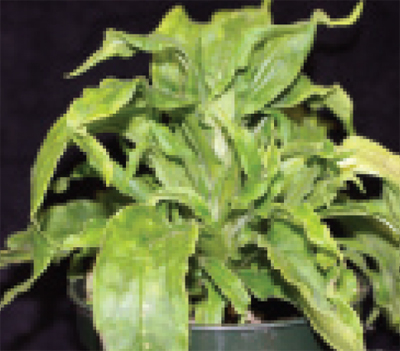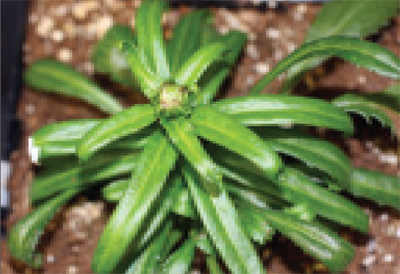Impatiens necrotic spotted wilt virus
July 8, 2015
Viruses
Pathogen
Impatiens necrotic spotted wilt virus (INSV).
Hosts include
Ajuga, Aster, Bracteantha, Camp-anula, Delphinium, Dianthus, Digitalis, Echinacea, Gaillardia, Gaura, Heuchera, Hosta, Leucanthe-mum, Lobelia, Lysimachia, Monarda, Oenothera, Penstemon, Phlox, Platycodon, Primula, Salvia, Scabiosa, Sedum, Tradescantia and Veronica.
Symptoms
Symptoms vary depending on the host but may include necrosis and spotting, ringspots, mosaic, mottling, distortion of new growth, stunting and plant death.

Mottling and distortion on foliage of Bracteantha caused by INSV.
Spread
INSV is spread by western flower thrips. Once a thrips acquires INSV, it can vector the virus to susceptible hosts it feeds on throughout its lifetime. The pathogen can also be spread by sap transmission. Plants can be infected and show no symptoms; the virus can be spread from these plants. INSV can overwinter in the roots of infected plants.
Management
Scout incoming plant material for signs of disease and for thrips.

Puckering and thickening of Leucanthemum foliage infected with INSV.
Susceptible plants should be scouted regularly for thrips (see thrips section for more information). Avoid intermixing of more and less susceptible crops within the same greenhouse. Also avoid intermixing seed- and cutting-propagated crops. Eliminate weeds from the propagation area. Immediately remove symp-tomatic plants from the growing area. Diagnostic testing can be done by a plant diagnostic lab or at the growing facility with testing strips available from plant diagnostic companies.

Downward curling caused by INSV.
Print a PDF of this page: Impatiens necrotic spotted wilt virus.



 Print
Print Email
Email



